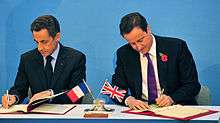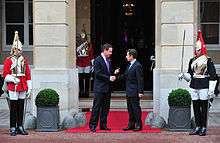The Lancaster House Treaties (2010)
 Cameron and Sarkozy sign the Defence and Security Co-operation Treaty during the UK-France summit at Lancaster House, in London. | |
| Type | Defence treaties |
|---|---|
| Signed | 2 November 2010 |
| Location | London, England |
| Parties | France, United Kingdom |


The Lancaster House Treaties of 2010 are two treaties between the United Kingdom and France for defence and security cooperation.[1][2] They were signed at 10 Downing Street on 2 November 2010 by British Prime Minister David Cameron and French President Nicolas Sarkozy.[3]
Downing Street Declaration
The 2 November 2010 Downing Street declaration[4] by President Sarkozy and Prime Minister Cameron. The elements of this declaration are as follows.
- Defence and Security Cooperation Treaty: The purpose of this is to develop co-operation between British and French Armed Forces, the sharing and pooling of materials and equipment including through mutual interdependence, the building of joint facilities, mutual access to each other’s defence markets, and industrial and technological co-operation.
- Nuclear Stockpile Stewardship: Collaboration on the technology associated with nuclear stockpile stewardship in support of both countries' independent nuclear deterrent capabilities, including a new joint facility at Valduc in France that will model performance of nuclear warheads and materials to ensure long-term viability, security and safety – this will be supported by a joint Technology Development Centre at Aldermaston in the UK.
- Operational Matters: It was also decided to sign a Letter of Intent, creating a new framework for exchanges between UK and French Armed Forces on operational matters.
- Industry and Armaments: It was decided to direct the UK-France High Level Working Group to strengthen its work on industrial and armament cooperation.
Operations and training
Combined Joint Expeditionary Force
It was decided to develop a Combined Joint Expeditionary Force (CJEF) suitable for a wide range of scenarios, up to and including high intensity operations. It will involve all three armed Services: there will be a land component composed of formations at national brigade level, maritime and air components with their associated Headquarters, and logistics and support functions. It will not involve standing forces but will be available at notice for bilateral, NATO, European Union, United Nations or other operations. It will begin with combined air and land exercises during 2011 and will develop the concept before the next UK-France Summit and progress towards full capability in subsequent years. The Force is intended to stimulate greater interoperability and coherence in military doctrine, training and equipment requirements.
Aircraft carriers
The UK had earlier announced its decision to install catapults and arresting gear on its new aircraft carriers (currently under construction) which French aircraft would be capable of using, creating opportunities for UK and French aircraft to operate off carriers from both countries. Building primarily on maritime task group co-operation around the French carrier Charles de Gaulle, the UK and France would have aimed to have, by the early 2020s, the ability to deploy a UK-French integrated carrier strike group incorporating assets owned by both countries. This was to ensure that the Royal Navy and the French Navy would work in the closest co-ordination. The decision to install the catapults and arresting gear was later reversed.
Equipment and capabilities
They agreed cooperation in the following areas.
- A400M support and training.
- Submarine technologies and systems
- Maritime mine countermeasures
- Satellite communications
- Air to air refuelling and passenger air transport
- Unmanned air systems
- A 10-year strategic plan for the British and French Complex Weapons sector.
- Research and technology
- To continue with their significant R&T co-operation, devoting an annual budget of €50m each to shared research and development, with the aim of increasing this where possible.
- To focus on a set of 10 priority areas that will include time critical research support to satellite communications, unmanned systems, naval systems and complex weapons. including new areas of critical industrial importance such as sensors, electronic warfare technologies, and materials, as well as novel areas such as simulation and a jointly funded PhD programme.
- Cyber security. France and the UK agreed a framework which will govern their enhanced co-operation in this area, leading to strengthened individual and common resilience.
Counter-terrorism
To develop co-operation in the following areas:
- The early detection of terrorist activities and terrorist recruitment.
- The sharing of information on changes in the national threat level.
- The prevention of terrorism through nuclear, radiological, biological, chemical and explosive devices, including through the Cyclamen programme for screening traffic passing through the Channel Tunnel;
- The protection of our populations and critical infrastructure.
- The security of commercial aviation.
- Support in building the capacity of countries outside Europe for the fight against terrorism.
International security

France and UK agreed that they would pursue closer co-operation across the board between NATO and the EU, and a lasting partnership between NATO and Russia based on practical co-operation and reciprocity.
34th Franco-British Summit
A follow up meeting occurred on 3 March 2016, with further pledges on counter terrorism, military defence, civil nuclear work and migration.[5]
Relationship to European Union Defence Policy
The treaty is bilateral between the UK and France and does not have a formal link with the European Union’s Common Security and Defence Policy. It does not use the separate Lisbon Treaty’s Permanent Structured Cooperation facility, nor involve the European Defence Agency.
See also
References
- ↑ "Treaty between the UK and the French Republic for Defence and Security Co-operation" (PDF). Fco.gov.uk.
- ↑ "Treaty between the United Kingdom of Great Britain and Northern Ireland and the French Republic relating to Joint Radiographic/Hydrodynamics Facilities" (PDF). Fco.gov.uk.
- ↑ "Tuesday 2 November 2010 UK-France Summit press conference". Fco.gov.uk.
- ↑ "Tuesday 2 November 2010 UK–France Summit 2010 Declaration on Defence and Security Co-operation". Number10.gov.uk.
- ↑ "UK-France Summit 2016: documents - Publications". www.gov.uk. Retrieved 2016-09-20.